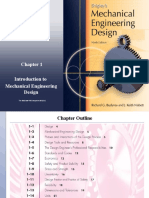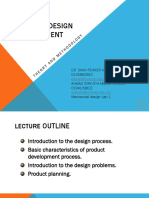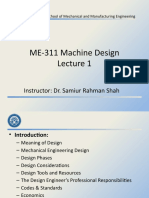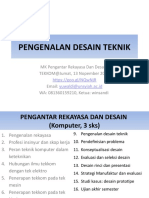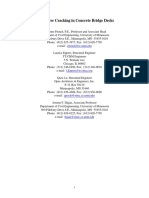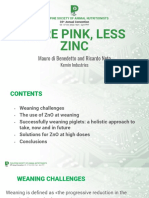CH 1 Slides
CH 1 Slides
Uploaded by
Juarez Medina IVCopyright:
Available Formats
CH 1 Slides
CH 1 Slides
Uploaded by
Juarez Medina IVOriginal Title
Copyright
Available Formats
Share this document
Did you find this document useful?
Is this content inappropriate?
Copyright:
Available Formats
CH 1 Slides
CH 1 Slides
Uploaded by
Juarez Medina IVCopyright:
Available Formats
Chapter Outline
Shigley’s Mechanical Engineering Design
What is Design?
To formulate a plan for the satisfaction of a specified need
Process requires innovation, iteration, and decision-making
Products should be
◦ Functional
◦ Safe
◦ Reliable
◦ Competitive
◦ Usable
◦ Manufacturable
◦ Marketable
Shigley’s Mechanical Engineering Design
Mechanical Engineering Design
Mechanical engineering design involves all the disciplines of
mechanical engineering.
Example
◦ Journal bearing: fluid flow, heat transfer, friction, energy
transport, material selection, thermomechanical treatments,
statistical descriptions, etc.
Shigley’s Mechanical Engineering Design
The Design Process
Iterative
in nature
Requires initial estimation,
followed by continued
refinement
Shigley’s Mechanical Engineering Design
Identification of Need
Understand the problem
Carefully read, understand and refine the problem statement
Shigley’s Mechanical Engineering Design
Definition of Problem
Problem definition is most significant step in the engineering
design process
Identify the known and unknown parameters.
Formulate the refined problem statement
Shigley’s Mechanical Engineering Design
Synthesis
State what must be determine to arrive at a solution to the
problem.
Sketch the components or system
Create a flowchart of the steps necessary to reach the final
solution.
The step may be: Free body diagram, Material properties,
equations from the text, etc.
State all assumptions
Conceptual design
Alternate design
Shigley’s Mechanical Engineering Design
Analysis
Using your solution strategy, analysis the problem using exact
equation or numerical tools.
References all sources of equations, tables, charts, software
results, etc.
Analytical or numerical (FEA) analysis of design to meet
standards requirement
If not meet standards, redesign the product
If meet requirements, go for evaluation (prototype testing
Shigley’s Mechanical Engineering Design
Evaluation
Prototype testing:
Actual test of the product to check whether it pass or fail
Presentation:
Present the product for marketing and production
Shigley’s Mechanical Engineering Design
Design Considerations
Some characteristics that influence the design
Shigley’s Mechanical Engineering Design
Computational Tools
Computer-Aided Engineering (CAE)
◦ Any use of the computer and software to aid in the
engineering process
◦ Includes
Computer-Aided Design (CAD)
Drafting, 3-D solid modeling, etc.
Computer-Aided Manufacturing (CAM)
CNC toolpath, rapid prototyping, etc.
Engineering analysis and simulation
Finite element, fluid flow, dynamic analysis, motion, etc.
Math solvers
Spreadsheet, procedural programming language, equation solver,
etc.
Shigley’s Mechanical Engineering Design
A Few Useful Internet Sites
www.globalspec.com
www.engnetglobal.com
www.efunda.com
www.thomasnet.com
www.uspto.gov
Shigley’s Mechanical Engineering Design
The Design Engineer’s Professional Responsibilities
Satisfy the needs of the customer in a competent, responsible,
ethical, and professional manner.
Some key advise for a professional engineer
◦ Be competent
◦ Keep current in field of practice
◦ Keep good documentation
◦ Ensure good and timely communication
◦ Act professionally and ethically
Shigley’s Mechanical Engineering Design
Ethical Guidelines for Professional Practice
National Society of Professional Engineers (NSPE) publishes a
Code of Ethics for Engineers and an Engineers’ Creed.
www.nspe.org/ethics
Six Fundamental Canons
Engineers, in the fulfillment of their professional duties, shall:
◦ Hold paramount the safety, health, and welfare of the public.
◦ Perform services only in areas of their competence.
◦ Issue public statements only in an objective and truthful
manner.
◦ Act for each employer or client as faithful agents or trustees.
◦ Avoid deceptive acts.
◦ Conduct themselves honorably, responsibly, ethically, and
lawfully so as to enhance the honor, reputation, and usefulness
of the profession.
Shigley’s Mechanical Engineering Design
NSPE Engineers’ Creed
As a Professional Engineer I dedicate my professional
knowledge and skill to the advancement and betterment of
human welfare.
I pledge:
◦ To give the utmost of performance;
◦ To participate in none but honest enterprise;
◦ To live and work according to the laws of man and the highest
standards of professional conduct;
◦ To place service before profit, the honor and standing of the
profession before personal advantage, and the public welfare
above all other considerations.
In humility and with need for Divine Guidance, I make this
pledge.
Shigley’s Mechanical Engineering Design
Standards and Codes
Standard
◦ A set of specifications for parts, materials, or processes
◦ Intended to achieve uniformity, efficiency, and a specified
quality
◦ Limits the multitude of variations
Code
◦ A set of specifications for the analysis, design, manufacture,
and construction of something
◦ To achieve a specified degree of safety, efficiency, and
performance or quality
◦ Does not imply absolute safety
Various organizations establish and publish standards and codes
for common and/or critical industries
Shigley’s Mechanical Engineering Design
Standards and Codes
Some organizations that establish standards and codes of
particular interest to mechanical engineers:
Shigley’s Mechanical Engineering Design
Economics
Cost is almost always an important factor in
engineering design.
Use of standard sizes is a first principle of cost
reduction.
Table A-17 lists some typical preferred sizes.
Certain common components may be less expensive
in stocked sizes.
Shigley’s Mechanical Engineering Design
Tolerances
Close tolerances generally
increase cost
◦ Require additional
processing steps
◦ Require additional
inspection
◦ Require machines with
lower production rates
Shigley’s Mechanical Engineering Design
Breakeven Points
A cost comparison between two possible production methods
Often there is a breakeven point on quantity of production
EXAMPLE
Automatic screw
machine
25 parts/hr
3 hr setup
$20/hr labor cost
Hand screw machine
10 parts/hr
Minimal setup
$20/hr labor cost
Breakeven at 50 units
Shigley’s Mechanical Engineering Design
Stress and Strength
Strength
◦ An inherent property of a material or of a mechanical element
◦ Depends on treatment and processing
◦ May or may not be uniform throughout the part
◦ Examples: Ultimate strength, yield strength
Stress
◦ A state property at a specific point within a body
◦ Primarily a function of load and geometry
◦ Sometimes also a function of temperature and processing
Shigley’s Mechanical Engineering Design
Uncertainty
Common sources of uncertainty in stress or strength
Shigley’s Mechanical Engineering Design
Uncertainty
Stochastic method
◦ Based on statistical nature of the design parameters
◦ Focus on the probability of survival of the design’s function
(reliability)
◦ Often limited by availability of statistical data
Shigley’s Mechanical Engineering Design
Uncertainty
Deterministic method
◦ Establishes a design factor, nd
◦ Based on absolute uncertainties of a loss-of-function
parameter and a maximum allowable parameter
◦ If, for example, the parameter is load, then
Shigley’s Mechanical Engineering Design
Design Factor Method
Often used when statistical data is not available
Since stress may not vary linearly with load, it is more common
to express the design factor in terms of strength and stress.
All loss-of-function modes must be analyzed, and the mode with
the smallest design factor governs.
Stress and strength terms must be of the same type and units.
Stress and strength must apply to the same critical location in
the part.
The factor of safety is the realized design factor of the final
design, including rounding up to standard size or available
components.
Shigley’s Mechanical Engineering Design
Example 1-2
Solution
Answer
Answer
Shigley’s Mechanical Engineering Design
Reliability
Reliability,R – The statistical measure of the probability that a
mechanical element will not fail in use
Probability of Failure, p – the number of instances of failures
f
per total number of possible instances
Example: If 1000 parts are manufactured, with 6 of the parts
failing, the reliability is
or 99.4 %
Shigley’s Mechanical Engineering Design
Reliability
Series System – a system that is deemed to have failed if any
component within the system fails
The overall reliability of a series system is the product of the
reliabilities of the individual components.
n
R Ri (1-5)
i 1
Example: A shaft with two bearings having reliabilities of 95%
and 98% has an overall reliability of
R = R1 R2 = 0.95 (0.98) = 0.93 or 93%
Shigley’s Mechanical Engineering Design
Dimensions and Tolerances
Nominal size – The size we use in speaking of an element.
◦ Is not required to match the actual dimension
Limits – The stated maximum and minimum dimensions
Tolerance – The difference between the two limits
Bilateral tolerance – The variation in both directions from the
basic dimension, e.g. 1.005 ± 0.002 in.
Unilateral tolerance – The basic dimension is taken as one of
the limits, and variation is permitted in only one direction, e.g.
Shigley’s Mechanical Engineering Design
Dimensions and Tolerances
Clearance – Refers to the difference in sizes of two mating
cylindrical parts such as a bolt and a hole.
◦ Assumes the internal member is smaller than the external
member
◦ Diametral clearance – difference in the two diameters
◦ Radial clearance – difference in the two radii
Interference – The opposite of clearance, when the internal
member is larger than the external member
Allowance – The minimum stated clearance or the maximum
stated interference or mating parts
Shigley’s Mechanical Engineering Design
You might also like
- CH - 1 - Introduction To Mechanical DesignNo ratings yetCH - 1 - Introduction To Mechanical Design65 pages
- Shigley's Mechanical Engineering DesignNo ratings yetShigley's Mechanical Engineering Design39 pages
- Concurrent Engineering Product Innovation Tools Process Innovation Tools Innovation ManagementNo ratings yetConcurrent Engineering Product Innovation Tools Process Innovation Tools Innovation Management71 pages
- Introduction To Mechanical Engineering DesignNo ratings yetIntroduction To Mechanical Engineering Design67 pages
- Minor Project Innovative Design of Modern Spanner Tool: Presentation OnNo ratings yetMinor Project Innovative Design of Modern Spanner Tool: Presentation On23 pages
- CHAP1 - Product Design Theory and MethodologyNo ratings yetCHAP1 - Product Design Theory and Methodology61 pages
- IE 447 CIM Lecture Notes - Chapter 5: Concurrent Engineering - 44No ratings yetIE 447 CIM Lecture Notes - Chapter 5: Concurrent Engineering - 447 pages
- Introduction of Design of Machine ElementNo ratings yetIntroduction of Design of Machine Element52 pages
- Product Design and Development: Prof. Inderdeep SinghNo ratings yetProduct Design and Development: Prof. Inderdeep Singh56 pages
- Chapter 9- Engineering Design and Project management PhungLeNo ratings yetChapter 9- Engineering Design and Project management PhungLe83 pages
- Machine Design Ashish Agarwal R.V.C.E, Bangalore: DR P R Venkatesh, Mech Dept, RVCE, BangaloreNo ratings yetMachine Design Ashish Agarwal R.V.C.E, Bangalore: DR P R Venkatesh, Mech Dept, RVCE, Bangalore144 pages
- Concept Validation and Design Synthesis of Car Dashboard As Per Plastic Trim StandardNo ratings yetConcept Validation and Design Synthesis of Car Dashboard As Per Plastic Trim Standard6 pages
- 17S1 - MA4001 - LD - Detail Design Lesson 9 - V1.1No ratings yet17S1 - MA4001 - LD - Detail Design Lesson 9 - V1.128 pages
- LECTURE NOTES ON Design For ManufacturinNo ratings yetLECTURE NOTES ON Design For Manufacturin63 pages
- Lecture 1 Introduction To Mechanical Engineering DesignNo ratings yetLecture 1 Introduction To Mechanical Engineering Design42 pages
- Mechanical Production Engineer Success: Careers, Interview Q&A, and TerminologyFrom EverandMechanical Production Engineer Success: Careers, Interview Q&A, and TerminologyNo ratings yet
- Acute Cellulitis and Erysipelas in Adults - Treatment - UpToDateNo ratings yetAcute Cellulitis and Erysipelas in Adults - Treatment - UpToDate28 pages
- Creating An Integrated E-Commerce StrategyNo ratings yetCreating An Integrated E-Commerce Strategy24 pages
- Chapter 10: Vibration Isolation of The SourceNo ratings yetChapter 10: Vibration Isolation of The Source12 pages
- S.M.A.R.T Practice: Specific, Measurable, Achievable, Relevant, Time-Bound Practice For A Greener CommunityNo ratings yetS.M.A.R.T Practice: Specific, Measurable, Achievable, Relevant, Time-Bound Practice For A Greener Community4 pages
- Stardew Valley Community Center Progress Paige100% (1)Stardew Valley Community Center Progress Paige5 pages
- Transverse Cracking in Concrete Bridge Decks: Cfrench@tc - Umn.eduNo ratings yetTransverse Cracking in Concrete Bridge Decks: Cfrench@tc - Umn.edu29 pages
- 1 Eastron SDM630MCT Smart Meter Modbus Protocol Implementation V1.7 1.1 Modbus Protocol OverviewNo ratings yet1 Eastron SDM630MCT Smart Meter Modbus Protocol Implementation V1.7 1.1 Modbus Protocol Overview24 pages
- Cooling and Heating Systems With Geothermal Pump For Heritage BuildingsNo ratings yetCooling and Heating Systems With Geothermal Pump For Heritage Buildings6 pages
- Potopna Crpka PEDROLLO VXC Vortex BrosuraNo ratings yetPotopna Crpka PEDROLLO VXC Vortex Brosura4 pages
- The Nordhaus-Gaddum Type Inequalities of A Alpha MatrixNo ratings yetThe Nordhaus-Gaddum Type Inequalities of A Alpha Matrix8 pages
- More Pink . Less Zinc . - Mauro Di BenedettoNo ratings yetMore Pink . Less Zinc . - Mauro Di Benedetto40 pages
- Concurrent Engineering Product Innovation Tools Process Innovation Tools Innovation ManagementConcurrent Engineering Product Innovation Tools Process Innovation Tools Innovation Management
- Minor Project Innovative Design of Modern Spanner Tool: Presentation OnMinor Project Innovative Design of Modern Spanner Tool: Presentation On
- IE 447 CIM Lecture Notes - Chapter 5: Concurrent Engineering - 44IE 447 CIM Lecture Notes - Chapter 5: Concurrent Engineering - 44
- Product Design and Development: Prof. Inderdeep SinghProduct Design and Development: Prof. Inderdeep Singh
- Chapter 9- Engineering Design and Project management PhungLeChapter 9- Engineering Design and Project management PhungLe
- Machine Design Ashish Agarwal R.V.C.E, Bangalore: DR P R Venkatesh, Mech Dept, RVCE, BangaloreMachine Design Ashish Agarwal R.V.C.E, Bangalore: DR P R Venkatesh, Mech Dept, RVCE, Bangalore
- Concept Validation and Design Synthesis of Car Dashboard As Per Plastic Trim StandardConcept Validation and Design Synthesis of Car Dashboard As Per Plastic Trim Standard
- 17S1 - MA4001 - LD - Detail Design Lesson 9 - V1.117S1 - MA4001 - LD - Detail Design Lesson 9 - V1.1
- Lecture 1 Introduction To Mechanical Engineering DesignLecture 1 Introduction To Mechanical Engineering Design
- Mechanical Production Engineer Success: Careers, Interview Q&A, and TerminologyFrom EverandMechanical Production Engineer Success: Careers, Interview Q&A, and Terminology
- Acute Cellulitis and Erysipelas in Adults - Treatment - UpToDateAcute Cellulitis and Erysipelas in Adults - Treatment - UpToDate
- S.M.A.R.T Practice: Specific, Measurable, Achievable, Relevant, Time-Bound Practice For A Greener CommunityS.M.A.R.T Practice: Specific, Measurable, Achievable, Relevant, Time-Bound Practice For A Greener Community
- Transverse Cracking in Concrete Bridge Decks: Cfrench@tc - Umn.eduTransverse Cracking in Concrete Bridge Decks: Cfrench@tc - Umn.edu
- 1 Eastron SDM630MCT Smart Meter Modbus Protocol Implementation V1.7 1.1 Modbus Protocol Overview1 Eastron SDM630MCT Smart Meter Modbus Protocol Implementation V1.7 1.1 Modbus Protocol Overview
- Cooling and Heating Systems With Geothermal Pump For Heritage BuildingsCooling and Heating Systems With Geothermal Pump For Heritage Buildings
- The Nordhaus-Gaddum Type Inequalities of A Alpha MatrixThe Nordhaus-Gaddum Type Inequalities of A Alpha Matrix








